
Associating Eupatoriums
A large perennial with natural charm
Contents
The Eupatorium is a tall perennial with corymb-like flowering, airy and somewhat blurred. It generally flowers from August to October, in shades of pink, lilac, purple, or white depending on the variety. Often reaching heights of 1.5 m to 2 m, there are also smaller varieties under 1 m. It is a plant of moist soil in its natural habitat; in the garden, a cool soil is a minimum for it to thrive quickly without drying out. If you can provide this condition, it will reward you with rapid growth and a stately, reliable presence, in full sun or possibly partial shade. Its natural charm lends itself to rather rustic yet varied settings. Discover how to pair this delightful tall perennial.
On banks, by the edge of a pond or in cool soil
The Eupatorium thrives best in fresh, rich, even heavy and moist soil. Accustomed to marshy areas in its natural habitat, it can, however, settle for soil that remains fresh all year round. Near a water point, a large Eupatorium like Eupatorium cannabinum ‘Plenum’ with its old rose corymbs enjoys being mixed with other perennials of similar appearance and conditions, such as the beautiful Filipendula rubra ‘Venusta’. A loosestrife, Lythrum salicaria, and a yellow loosestrife, Lysimachia ephemerum, join this ballet of airy plants punctuated by a Sanguisorba menziesii.

Sanguisorba menziesii, Filipendula venusta ‘Rubra’, Eupatorium cannabinum ‘Plenum’, Lysimachia ephemerum, Lythrum salicaria
In a naturalistic garden
Many grasses thrive in cool soils, and Piet Oudolf, a talented garden designer, has popularised mixes of single-flowered perennials with a natural appearance and numerous grasses. The Eupatorium, particularly Eupatorium maculatum ‘Riesenschirm’, is an iconic plant in his garden in Hummelo, where its impressive height and the beautiful depth of its purple corymbs can be appreciated.
In a similar spirit, let’s consider Eupatorium maculatum ‘Atropurpureum’, a tall variety reaching 2 m with almost black stems and purple corymbs. Pair it, for example, with Miscanthus sinensis ‘Ferner Osten’ with coppery purple highlights, an Echinacea, Echinacea purpurea ‘Summer Cocktail’, and the well-known and welcome Verbena bonariensis.
→ Visit the garden of Piet Oudolf in Hummelo
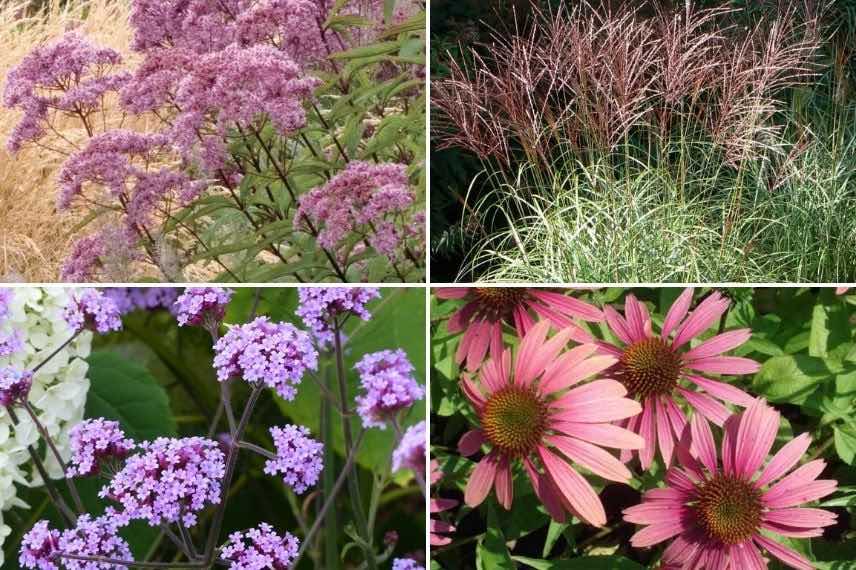
Eupatorium maculatum ‘Atropurpureum’, Miscanthus sinensis ‘Ferner Osten’, Echinacea purpurea ‘Summer Cocktail’, Verbena bonariensis
Discover other Eupatorium - Boneset
View all →Available in 1 sizes
Available in 2 sizes
Available in 1 sizes
Available in 1 sizes
Available in 2 sizes
Available in 1 sizes
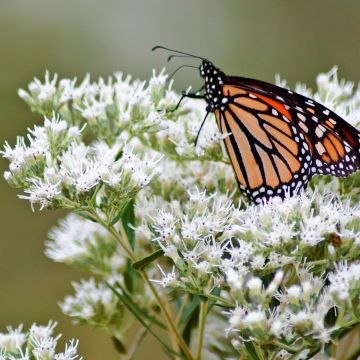
Available in 1 sizes
Available in 1 sizes
Available in 1 sizes
Available in 1 sizes
In Mixed-Border
Once again, provided you have cool soil, you can plant the Eupatorium away from the banks. The very lovely Eupatorium cœlestinum, which is much more modest in size at around 80 cm, has pastel blue to bright lilac corymbs and foliage that turns chartreuse green at flowering. Imagine it with all sorts of summer sun or partial shade perennials. Here it is with a Dahlia ‘Creme de Cassis’, an Aster dumosus ‘Lady in Blue’, and a Pennisetum orientale ‘Karley Rose’.
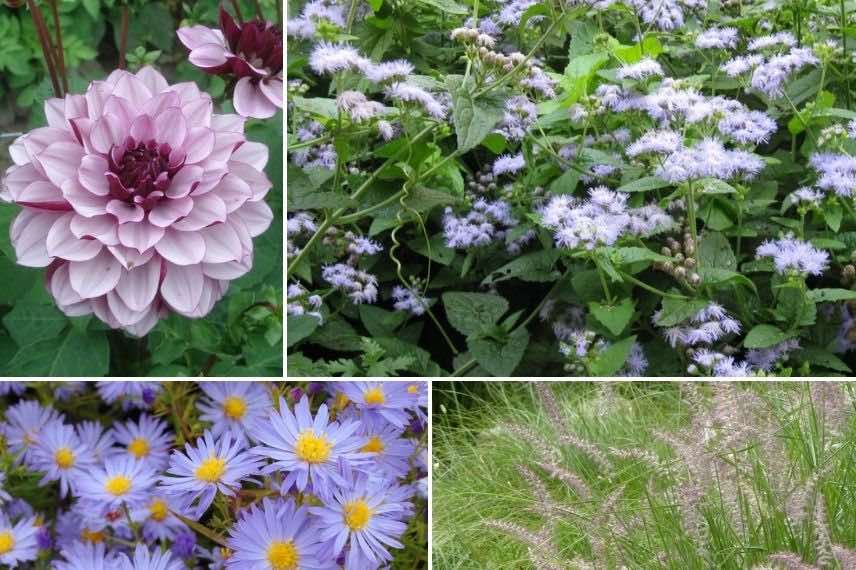
Dahlia ‘Creme de Cassis’, Eupatorium coelestinum, Pennisetum orientale ‘Karley Rose’, Aster dumosus ‘Lady in Blue’
In a well-drained bed
Once is not customary, the Eupatorium capillifolium ‘Elegant Plume’ prefers well-drained soils. It can even tolerate occasional drought. In full sun or partial shade, it displays its erect and graphic stature. It reaches 1.80 m with a modest footprint of 60 cm at ground level. Its stems are adorned with thread-like, feathery foliage of a soft green. At the end of summer, light, modest panicles of cream-pink to greenish flowers complete the plant.
If you have well-drained, yet cool, occasionally dry soil, install this remarkable perennial, a beautiful focal point that structures your border. It looks lovely mixed with grasses or alongside exotic plants, and can also be used among flowering plants to provide structure and lightness.
Here is a multicoloured proposal alongside a Persicaria amplexicaulis ‘Fat Domino’, an Echinops bannaticus ‘Taplow Blue’, a Digiplexis ‘Illumination Raspberry’ (derived from a Foxglove), an Helenium ‘Sahin’s Early Flowerer’, and a Sage Salvia farinacea ‘Victoria Blue’.
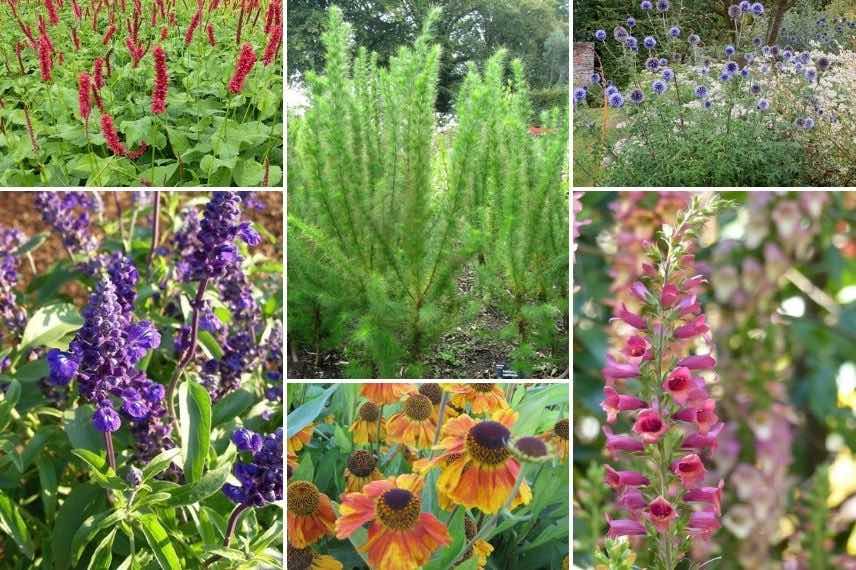
Persicaria amplexicaulis ‘Fat Domino’, Eupatorium capillifolium ‘Elegant Plume’, Echinops bannaticus ‘Taplow Blue’, Digiplexis ‘Illumination Raspberry’, Helenium ‘Sahin’s Early Flowerer’, Salvia farinacea ‘Victoria Blue’
In partial shade with beautiful foliage
Eupatorium also grows in its natural habitat at the forest edge. Try it in partial shade as long as it still receives several true hours of sunlight.
The Eupatorium rugosum ‘Chocolate’ features lovely chocolate foliage enhanced by white flowering. It can be planted in partial shade alongside plants that thrive in cool soil and have beautiful foliage. However, be sure to choose the sunniest spot for the Eupatorium, as it requires the most sunlight. Since it is water-hungry, a bit of shade can help temper this thirst. Here, it is paired with Brunnera macrophylla ‘Looking Glass’, and Brunnera ‘Betty Bowring’, with an Hosta ‘Auguste Moon’ and Cimicifuga ‘Carbonella’.

Brunnera macrophylla ‘Looking Glass’, Eupatorium rugosa ‘Chocolate’, Brunnera ‘Betty Bowring’, Hosta ‘Auguste Moon’, Cimicifuga carbonella
In a grass garden
Have you ever witnessed the spectacle of a grass garden through the seasons? The way they shimmer in the sun during flowering, how they catch the frost in winter, how they dance in the wind. Moreover, even the deciduous ones are present for almost the entire year since their foliage is cut back in February or March before the new shoots appear. As mentioned earlier, many appreciate cool soils. Eupatorium, with its bushy habit, can find a place among these grasses. The tallest varieties are particularly interesting, as many large grasses can outgrow most flowering perennials. Furthermore, they grow quickly.
The Eupatorium maculatum ‘Phantom’, a medium-sized variety with lilac corymbs, is here alongside Miscanthus sinensis ‘Red Chief’, Calamagrostis brachytricha, and Panicum virgatum ‘Purple Breeze’.

Miscanthus sinensis ‘Red Chief’, Eupatorium maculatum ‘Phantom’, Calamagrostis brachytricha, Panicum virgatum ‘Purple Breeze’
In an exotic bed
Let’s revisit the Eupatorium capillifolium ‘Elegant Plume’ this time in an exotic setting. It easily finds its place with its unusual appearance, great stature, and architectural habit.
It is accompanied by a Sanguisorba hakusanensis, a Daylily ‘Amerstone Amethyst Jewel’, and a Colocasia ‘Black Magic’‘.

Eupatorium capillifolium ‘Elegant Plume’, Sanguisorba hakusanensis, Daylily ‘Amerstone Amethyst Jewel’, Colocasia ‘Black Magic’
- Subscribe!
- Contents


































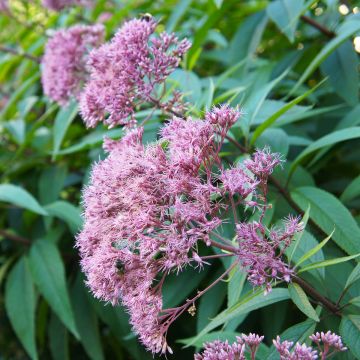
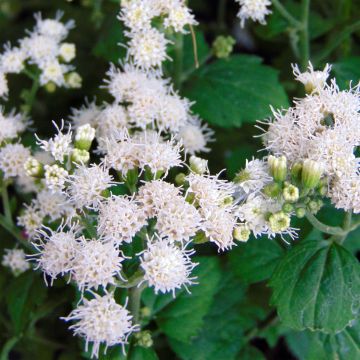



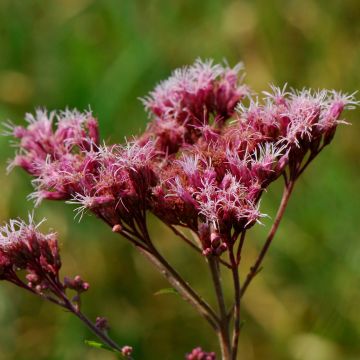
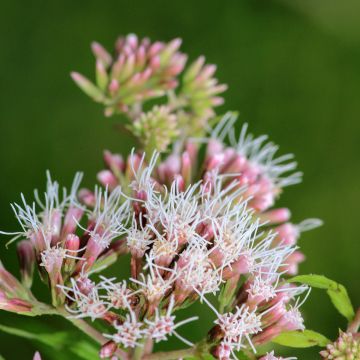
Comments